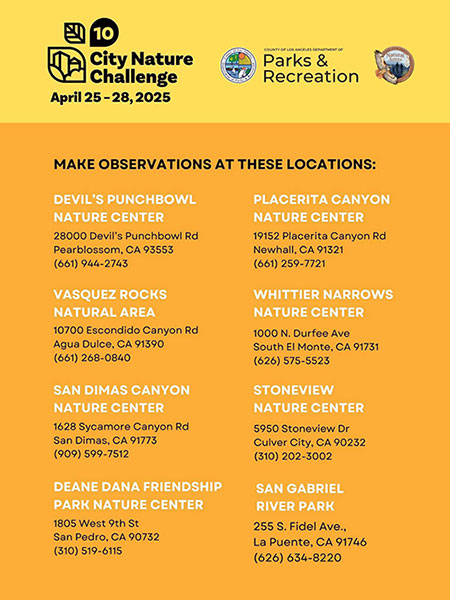
Pictured: Vasquez Rocks Natural Area Park in Los Angeles, California. Photo by angeldibilio, courtesy of Adobe Stock.
In a world grappling with climate change, habitat loss and biodiversity decline, science must evolve to be more inclusive, grounded in place, and connected to the people who live there. Community science rises to meet that need. It invites the public to play an active role in scientific discovery and data collection, often in the very parks and neighborhoods we call home.
At its heart, community science is about empowerment. It allows people — regardless of background or formal training — to participate in meaningful scientific efforts. Whether observing a hawk soaring overhead, photographing a rare wildflower, or recording the first signs of an invasive insect, participants contribute valuable knowledge while deepening their own relationship with the natural world. With tools like smartphones and platforms such as iNaturalist, just about anyone can help expand our collective understanding of biodiversity.
Why Community Science Matters
The benefits of community science ripple outward. For scientists, the involvement of thousands of observers expands the volume and geographic reach of data. For communities, it fosters curiosity, learning and stewardship. For parks, it breathes life into public spaces, building stronger connections between visitors and the land. And perhaps most importantly, community science makes research available for all. By lowering barriers to entry and welcoming people of all ages, backgrounds and abilities, it redefines who gets to participate in the scientific process.
A Global Snapshot: The City Nature Challenge
One powerful example of community science in action is the City Nature Challenge (CNC), an annual global BioBlitz that mobilizes cities to document local biodiversity over four days. Co-founded by the Natural History Museum of Los Angeles County and the California Academy of Sciences, the CNC has grown into a worldwide event. Participants use the iNaturalist app to upload photos and observations of wild plants, animals, and fungi, contributing to research and helping illuminate the hidden life all around us.
This year’s City Nature Challenge takes place from April 25 to 28, 2025, with a follow-up identification period running through May 4. Observations recorded during this window will help scientists better understand urban ecosystems while giving individuals a chance to engage with their local environment in a new and exciting way.

Los Angeles County Joins the Effort
As both a steward of public parkland and a leading provider of nature-based education, the Los Angeles County Department of Parks and Recreation (DPR) plays a key role in connecting residents with the natural world. In support of CNC, DPR is hosting events at nature centers and natural areas throughout the region. These sites — including Devil’s Punchbowl in Pearblossom, Placerita Canyon in Newhall, Vasquez Rocks in Agua Dulce, and several others — offer exciting, welcoming spaces for visitors to explore and document nature.
The County’s Chief Sustainability Office (CSO) is also a proud supporter and promoter of the CNC, reflecting the County’s commitment to engage the public in environmental stewardship and nature-based learning. The OurCounty Sustainability Plan includes a dedicated action—Action 147 — indicating the County’s support for increasing participation in community science initiatives like the CNC.
Why Parks Are a Natural Fit
Community science aligns with the mission of parks and recreation. It enhances outdoor education by integrating science into nature walks, junior ranger programs, and seasonal events. It fosters a sense of place by encouraging people to slow down, observe, and appreciate the life around them. It can also support better park management, as data collected by the public helps identify trends in species populations, guide restoration projects, and reveal conservation needs.
Just as importantly, community science builds advocates. People who participate in these efforts often form lasting bonds with the places and spaces they explore, leading to stronger public support for parks, open spaces, and environmental protection. This type of engagement can be especially impactful in historically underserved communities, where culturally relevant, accessible opportunities for environmental education have been too limited for too long.
How to Get Involved
For those looking to get involved, the opportunities are plentiful. Park professionals and volunteers can promote CNC events through social media, newsletters, and signage. Hosting a BioBlitz — even on a small scale — can yield hundreds of observations and foster meaningful conversations about local wildlife. Collaborating with nature centers, museums, environmental nonprofits, community-based organizations and other partners can bring added expertise and energy to the table. Also, getting youth involved through school programs, camps and after-school activities ensures the next generation of observers and advocates is already growing strong.
Another way you can get involved with community science is by participating in NRPA’s Parks for Pollinators BioBlitz.
Looking Ahead
Community science is about more than just collecting data — it is about making connections. It brings people closer to nature, ties communities more deeply to their parks and neighborhoods, and gives public voices a role in shaping scientific understanding. As the 2025 City Nature Challenge approaches, there has never been a better time to get involved. Whether you are a park planner, a parent, a student or a nature lover, you can help tell the story of your community’s biodiversity. All it takes is a moment of observation — and a willingness to look more closely at the world around you.
Clement Lau, DPPD, FAICP, is a Senior Analyst with the Los Angeles County Chief Sustainability Office. He was previously a Departmental Facilities Planner with the County’s Department of Parks and Recreation.
Resources:
- For more information about community science, please visit https://nhm.org/community-science-nhm
- For more information about the City Nature Challenge, please visit https://www.citynaturechallenge.org/
- For more information on the NRPA Parks for Pollinators BioBlitz, please visit https://www.nrpa.org/bioblitz/


